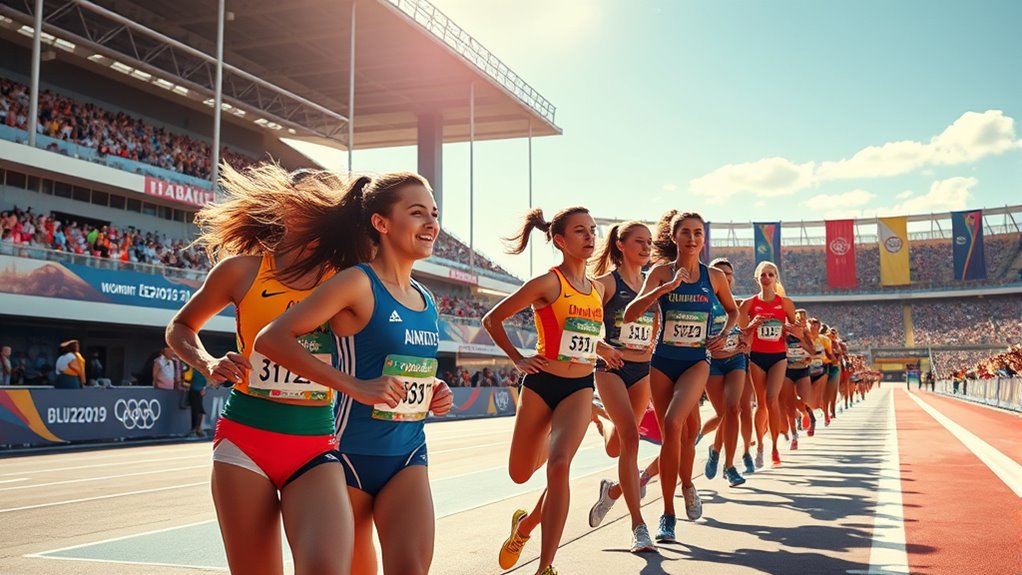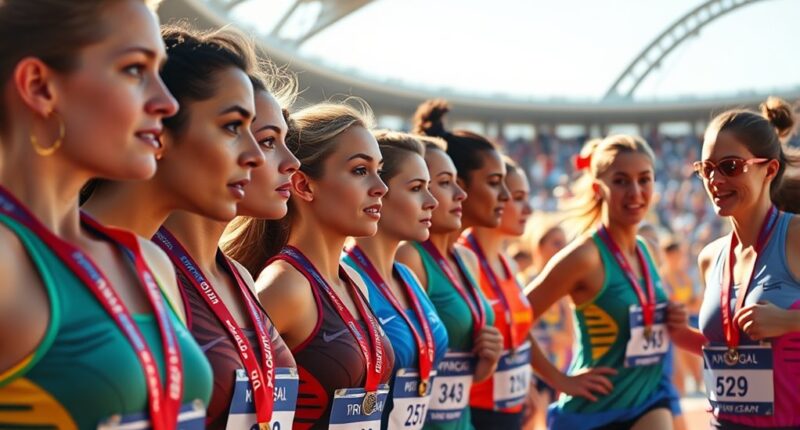Women’s marathon has come a long way, moving from societal bans and misconceptions about women’s health to becoming a symbol of equality. Despite early restrictions, women persisted, proving they could compete at the highest level. Scientific advances and cultural shifts helped break barriers, leading to Olympic inclusion and record-breaking performances. This journey showcases resilience and progress in gender equality. To discover how women achieved this remarkable transformation, continue exploring their inspiring story.
Key Takeaways
- Societal norms once viewed women’s marathon running as harmful, leading to bans and restrictions.
- Advocates and athletes challenged barriers, gradually changing perceptions and enabling women’s participation.
- The inclusion of women’s marathon in the Olympics marks a significant step toward gender equality in sports.
- Advances in training, science, and technology have improved women’s performance and broken records.
- The marathon’s evolution symbolizes resilience, progress, and ongoing efforts toward gender parity in athletics.

The women’s marathon has evolved into a powerful symbol of athletic achievement and gender equality. When you think about how far women have come in long-distance running, it’s inspiring to realize that just a few decades ago, women were often barred from competing in marathons altogether. Today, women’s participation at the Olympic level showcases the progress made toward true gender equality, but reaching this point wasn’t easy. It involved challenging societal norms, overcoming institutional bans, and rethinking training techniques to meet the physical and mental demands of marathon running.
Back in the early days, societal perceptions about women’s physical capabilities limited their access to proper training resources. When women first started running marathons, many coaches and officials believed that long-distance running was harmful or even dangerous for women’s health. As a result, women faced bans and restrictions, which slowed their progress and visibility in the sport. However, dedicated athletes and advocates pushed forward, demonstrating that women could compete at the highest levels. Their perseverance helped change attitudes, but the shift didn’t happen overnight. It required a redefinition of training techniques tailored specifically for women, considering physiological differences and unique needs.
Today, you see women employing advanced training techniques that optimize performance while minimizing injury risks. These include tailored strength training, precise nutrition plans, and innovative recovery strategies. Coaches now develop personalized programs that account for hormonal cycles, injury prevention, and mental resilience. This evolution in training techniques has allowed women to push beyond previous limits, breaking records and inspiring future generations. You also notice that women’s marathons emphasize not just endurance but also mental toughness, with athletes adopting mental training techniques like visualization and mindfulness. These methods help women stay focused and resilient during grueling race conditions, further leveling the playing field.
The progress from bans to the Olympic start line reflects a broader societal shift and a commitment to gender equality in sports. Women now train with the same intensity and scientific support as their male counterparts, challenging stereotypes along the way. Your understanding of this evolution reminds you that perseverance, scientific innovation, and cultural change are key drivers behind the rise of women’s marathon running. It’s a story of resilience and determination, proving that when barriers are lifted, women can achieve extraordinary feats. As you watch women race on Olympic streets today, you see not just a testament to how far gender equality in sports has come—and how much further it can go.
Frequently Asked Questions
When Was the First Official Women’s Marathon Held?
You’ll find that the first official women’s marathon was held in 1984 at the Los Angeles Olympics. This milestone marked a significant moment in sports history, breaking societal barriers and inspiring future generations. It symbolized progress in gender equality and challenged traditional norms. The event’s success demonstrated how societal impacts can drive change, paving the way for women to compete in long-distance running and achieve recognition on the world stage.
How Have Training Methods Evolved for Female Marathon Runners?
You might be surprised to learn that training methods for female marathon runners have advanced considerably, thanks to training innovations and improved nutrition strategies. You now focus more on personalized plans, strength training, and recovery techniques, unlike earlier generic approaches. These advancements help you build endurance and prevent injuries. As a result, women can train smarter, pushing boundaries further and competing at higher levels, all while maintaining ideal health and performance.
What Are the Current World Records for Women’s Marathon?
The current women’s marathon world record is 2:14:04, set by Brigid Kosgei in 2019. In the historical context of record progression, you can see how advances in training, nutrition, and technology have markedly improved performance over the years. You’ll notice the record has continually dropped, reflecting the evolution of competitive standards and the increasing support for female athletes in marathon running.
How Do Gender Disparities Impact Women’s Marathon Sponsorships?
Like a shadow cast by the greats, gender disparities impact women’s marathon sponsorships today. You notice sponsorship inequality and limited media representation, which hinder visibility and financial support for female runners. This imbalance discourages participation, stalls growth, and perpetuates stereotypes. To change the narrative, you can advocate for equitable sponsorships and increased media coverage, ensuring women’s marathons receive the recognition they deserve and inspiring future generations of athletes.
What Challenges Do Women Face in Qualifying for Olympic Marathons?
You face significant challenges in qualifying for Olympic marathons due to gender bias and sponsorship obstacles. These biases often mean fewer opportunities and less support for women to compete at the highest level. Sponsorship obstacles can limit access to training resources and international competitions, making it harder to meet qualifying standards. Overcoming these hurdles requires increased awareness, equitable funding, and advocating for gender equality in athletics.
Conclusion
Today, you’ve seen how women’s marathon history has transformed from bans to Olympic glory, breaking barriers along the way. Imagine telling a 19th-century Victorian lady about women running 26.2 miles—she’d think it’s a scene from a sci-fi novel! Your journey through this evolution shows that perseverance and passion can turn impossible into inevitable. So, next time you lace up, remember, even the most historic hurdles can be overcome—just like those brave women who ran before you.









